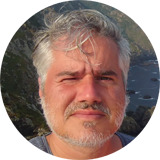Mapping Evapotranspiration and Crop Stress with Unmanned Aerial Vehicles: A Cost-effective Approach

Dr. Héctor Nieto, Ph.D.
ABSTRACT
The growing population is facing crucial challenges for ensuring current and future food production, which is exacerbated by the current scenario of climate change, with overall higher temperatures and more extreme drought and flood events. Agriculture is the most water demanding sector, with ca. 70% of total freshwater consumption worldwide, as it requires ensuring population food’s security. For that reason, as part of UNESCO’s Sustainable Development Goals, increasing water use efficiency is targeted. The use of Unmanned Aerial Vehicles (UAVs) for evapotranspiration (ET) and crop stress monitoring is one of the most promising digital tools in agriculture. Indeed UAVs can carry, in a cost-effective manner, remote sensing sensors and cameras that can provide the required inputs for spatially detailed evaluation of crop water status at field scale.
The thermal infrared based Two Source Energy Balance (TSEB) model has proven to be a robust modelling framework for monitoring ET that can be applied to a wide variety of climates, crop types and remote sensing platforms. In particular, we present here how TSEB was adapted for row crops and agroforestry systems, in which their uneven canopy distribution forces a very distinct radiation partitioning and turbulent exchange between soil, canopy and the atmosphere. In the case of UAV-based applications, specific costs due to purchase, maintenance, operation and post-processing could limit their feasibility and profitability, particularly for small-scale farmers or in crops with low marginal benefits. To reduce these constraints, we also evaluated and developed low-cost and automatic solutions for image capture and postprocessing, including the use of open-source image mosaicking and corregistration.
The thermal infrared based Two Source Energy Balance (TSEB) model has proven to be a robust modelling framework for monitoring ET that can be applied to a wide variety of climates, crop types and remote sensing platforms. In particular, we present here how TSEB was adapted for row crops and agroforestry systems, in which their uneven canopy distribution forces a very distinct radiation partitioning and turbulent exchange between soil, canopy and the atmosphere. In the case of UAV-based applications, specific costs due to purchase, maintenance, operation and post-processing could limit their feasibility and profitability, particularly for small-scale farmers or in crops with low marginal benefits. To reduce these constraints, we also evaluated and developed low-cost and automatic solutions for image capture and postprocessing, including the use of open-source image mosaicking and corregistration.
BIOSKETCH
Héctor Nieto is Tenured Scientist at CSIC’s Institute of Agricultural Sciences (ICA-CSIC) since December 2021. Before then he has held several positions working in both public research/academic institutions (University of Alcalá, University of Copenhaguen, IRTA, and the Agricultural Research Service) and the private sector (COMPLUTIG SL). His research has been focused in developing new knowledge in evapotranspiration modelling, focused on remote sensing applications at different scales from proximal sensing to airborne and satellite platforms. He has also been WP leader in international projects, such as ET4FAO and SENET both funded by the European Space Agency and lead by DHI, to evaluate Copernicus data for near-real time monitoring of evapotranspiration and water use at different spatial and temporal scales. These two projects have resulted in a freely open source tool for producing ET maps with Sentinel images (https://www.esa-sen4et.org/news6) and demonstrated to FAO the utility of Copernicus data for water accounting (https://et4fao.dhigroup.com/#/). His H-index is 25 with more than 70 publications registered in Scopus from which he has has more than 1800 citations. Besides the dissemination to the scientific community he also shares his models/algorithms in public open-source repositories at (https://github.com/hectornieto). Finally he has been co-supervisor of 4 graduated PhD students and is currently co-supervising another PhD student. He participated as well in high-education teaching, at either BSc, MSc and PhD levels, and capacity building activities, for which he distributes teaching material using the latest technologies that combine open source repositories, interactive notebooks and containerized software (https://mybinder.org/v2/gh/hectornieto/curso-WUE/HEAD).

